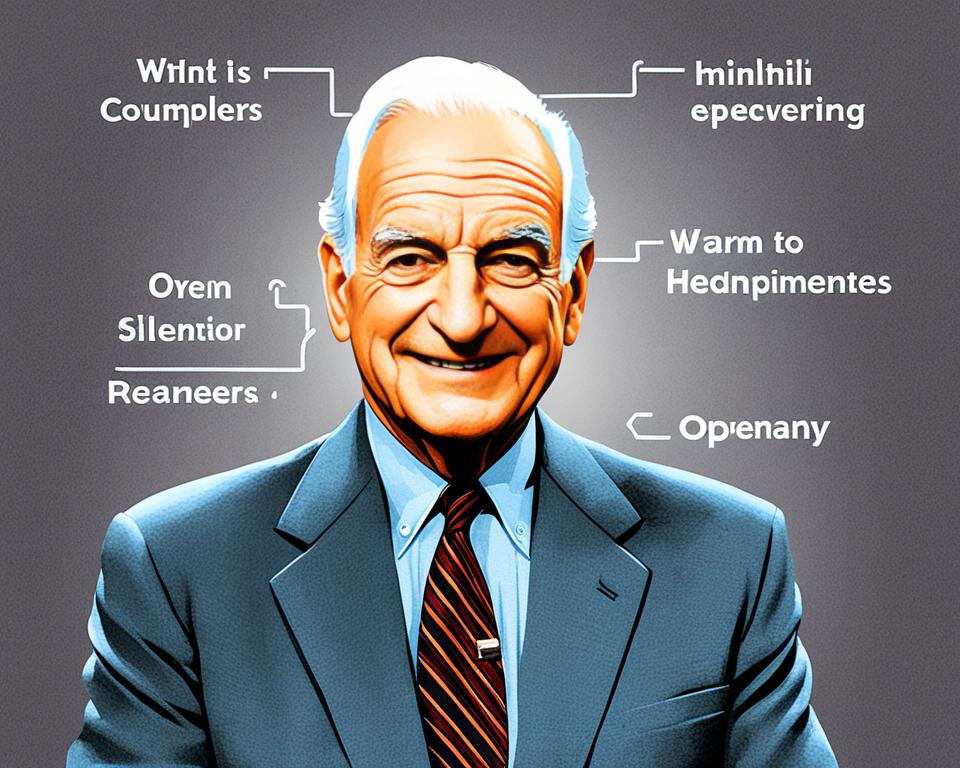Welcome to our comprehensive guide on the leadership style of Sam Walton, the renowned founder of Walmart. In this article, we’ll explore Walton’s management approach, business strategies, and the key factors that contributed to his success.
Key Takeaways:
- Sam Walton had a trusting and light-hearted leadership style.
- He believed in giving his employees maximum authority and responsibility.
- Walton hired ambitious and entrepreneurial individuals, even if they lacked experience.
- Positive feedback and incentives played a crucial role in motivating his team.
- Walton focused on maintaining a fun work environment and reducing bureaucracy.
Sam Walton’s leadership style and business strategies are still influential today. Let’s dive deeper into his management style and explore how his approach can inspire aspiring leaders and entrepreneurs.
Table of Contents
Sam Walton’s Management Style
Sam Walton’s management style was characterized by a trusting and light-hearted attitude. He believed in picking good people and giving them maximum authority and responsibility. Walton hired ambitious and entrepreneurial individuals, recognizing their potential even if they lacked experience at the time. He empowered his employees by giving them autonomy to run their departments like separate businesses.
Positive feedback played a crucial role in Walton’s leadership style, as he actively looked for opportunities to praise his employees. He believed that sincere words of praise were invaluable. Walton also encouraged open communication and made an effort to understand his employees’ thoughts and feelings.
Under Walton’s leadership, Walmart became known for its trusting and empowering work environment. Employees felt a sense of ownership and were motivated to excel in their roles. The autonomy given to the employees allowed them to make decisions and implement their ideas, fostering a culture of innovation and growth.
In addition, Walton’s positive feedback and recognition of employees’ efforts created a strong sense of loyalty and dedication. Associates felt valued and appreciated, leading to higher job satisfaction and productivity. Walton’s management style laid the foundation for Walmart’s success as a leading retail giant.
Sam Walton’s Management Style in Action
| Principles | Examples |
|---|---|
| Trusting attitude | Walton gave his employees autonomy and trusted them to make decisions, even during challenging times. |
| Autonomy | Employees were encouraged to take risks and run their departments like separate businesses, allowing for creativity and innovation. |
| Positive feedback | Walton actively sought opportunities to recognize and praise his employees, fostering a culture of appreciation and motivation. |
| Open communication | Walton believed in listening to his employees’ thoughts, ideas, and concerns, creating a supportive and collaborative environment. |
Sam Walton’s management style set a new standard for leadership in the business world. His emphasis on trust, autonomy, and positive feedback created a culture of empowerment and innovation at Walmart. By valuing and investing in his employees, Walton built a successful and sustainable company that continues to thrive to this day.
Motivating Your Team
In addition to giving his employees autonomy, Sam Walton employed various techniques to motivate his team and foster a high-performance culture. One of the key strategies Walton used was setting high goals and encouraging healthy competition among his employees. He firmly believed that competition fueled motivation and pushed individuals to strive for excellence.
To keep the team motivated and engaged, Walton made ambitious bets on the company’s performance. When the goals were met or exceeded, he rewarded employees with incentives and recognition. This not only reinforced a sense of accomplishment but also created a competitive spirit within the organization.
Another technique Walton employed was job rotation among his managers. By switching jobs with one another, managers were exposed to different aspects of the company, challenging them and broadening their understanding of the business. This approach helped them develop a comprehensive understanding of the entire corporation, enabling better decision-making and a more unified leadership approach.
Motivation Techniques Used by Sam Walton
- Setting high goals
- Encouraging healthy competition
- Rewarding performance
- Job rotation
Walton believed in holding Saturday morning management meetings to discuss successes, company strategy, and areas of improvement. These meetings provided a platform for open communication, allowing the team to share their experiences, challenges, and ideas. It also helped align everyone towards common goals and objectives.
By implementing these motivation techniques, Sam Walton created a dynamic and driven team that consistently achieved remarkable results. His emphasis on high goals, healthy competition, and recognition fostered a culture of continuous improvement and excellence.
| Techniques | Benefits |
|---|---|
| Setting high goals |
|
| Encouraging healthy competition |
|
| Rewarding performance |
|
| Job rotation |
|
Embracing a Fun Work Environment
Sam Walton believed in creating a fun work environment that would not only attract customers but also energize and motivate his employees. He understood the importance of infusing enthusiasm and enjoyment into the workplace to foster a positive and productive atmosphere. This emphasis on fun was deeply influenced by the small-town roots of Walmart, where community engagement and entertainment were essential elements of daily life.
To bring excitement and joy to the workplace, Walton embraced various fun management practices that set Walmart apart from other companies. One example of this was hiring bands and circuses to perform in parking lots, creating a festive atmosphere and drawing in crowds of curious onlookers. Additionally, Walmart organized promotional events like the famous “Moonlight Madness” sales, where customers were enticed by exclusive discounts and special deals in the late evening hours.
But it wasn’t just the customers who enjoyed these fun events. Walton encouraged his managers to have fun, show enthusiasm, and build a sense of spirit and excitement among their teams. He believed that when employees have fun at work, they are more engaged, motivated, and even more creative in finding solutions.
Creating a Lively and Engaging Atmosphere
At Walmart, the emphasis on a fun work environment extended beyond special events. Walton wanted his employees to enjoy their everyday work experience. He actively discouraged them from walking around with serious expressions and instead encouraged them to embrace the positive and enthusiastic vibe of the company. This created a lively and engaging atmosphere that made going to work feel less like a chore and more like an enjoyable experience.
By embracing a fun work environment, Walton understood the significance of capturing the team’s attention and keeping them interested. In a retail industry known for its fast-paced nature, maintaining high levels of enthusiasm was crucial for employee satisfaction and productivity.
To give you a glimpse of the fun work environment at Walmart, here’s an image that perfectly encapsulates the lively atmosphere:
Keeping the Store Small
Despite Walmart’s tremendous growth, Sam Walton remained committed to maintaining the small-store feel that characterized the company. He recognized that the individual store experiences played a significant role in reflecting the overall performance of the company. At senior management meetings, the focus was on understanding and improving the unique experiences and performances of each store.
Walton valued the opinions of individual employees, even those who may not have held managerial positions. For example, he sought the insights of truck drivers who had the opportunity to visit numerous stores. Their perspectives provided valuable insights into the operational aspects and customer experiences that could be improved. By actively involving employees at all levels, Walton fostered a sense of ownership and accountability throughout the organization.
Moreover, Walton had an aversion to bureaucracy and sought to reduce unnecessary layers within the company. Instead of adding temporary fixes by increasing the number of people involved, he aimed to address problems at their root cause. This streamlined approach allowed decisions to be made more efficiently, maintaining the nimbleness and agility of the company.
To illustrate the importance of maintaining the small-store feel, here is a brief snapshot of the individual store experiences that Sam Walton valued:
- Managers and employees wore nametags to foster a sense of familiarity and personal connection with customers.
- Store layouts were designed to prioritize convenience and ease of navigation, ensuring that customers could easily find what they needed.
- Strong relationships were built with local communities, where each store aimed to serve as a hub for customers to meet their everyday needs.
By maintaining the small-store feel and reducing bureaucracy, Sam Walton created a unique retail environment that prioritized individual store experiences and fostered a sense of community among employees and customers alike.
Effective Communication Methods
To keep associates connected across thousands of stores worldwide, Sam Walton recognized the importance of implementing effective communication methods at Walmart. Through various channels, the company ensured that employees stayed informed and engaged with the organization’s goals and strategies.
Wal-Mart World Publications
One of the key communication methods employed by Walmart was the publication of Wal-Mart World periodicals. These publications served as a valuable source of information for associates, providing updates on company news, success stories, and upcoming events. By sharing these publications, Walmart fostered a sense of unity and kept employees well-informed about the happenings within the organization.
TV Broadcasting in Break Rooms
Another effective communication method utilized by Walmart was TV broadcasting in break rooms. By strategically placing televisions in these communal areas, the company ensured that important announcements, company updates, and training videos reached a broad audience of employees. This approach allowed Walmart to disseminate information in a convenient and accessible manner, keeping associates connected and engaged during their downtime.
Headquarters Visits
Sam Walton believed in promoting cross-site knowledge exchange and fostering a sense of involvement and responsibility among employees. To achieve this, Walmart encouraged visits from local staff to headquarters and vice versa. These visits provided opportunities for associates to interact with leaders, gain insights into the company’s overall direction, and share their unique perspectives. By facilitating these visits, Walmart emphasized the importance of communication and collaboration across different levels and locations within the organization.
Regular Touchpoints with Departments
Effective communication at Walmart also involved regular touchpoints with all departments of the company. Walton understood that sharing information and responsibility at all levels fostered a sense of involvement and empowerment among employees. By ensuring open lines of communication and transparent sharing of news and information, Walmart created a culture where everyone felt valued and connected to the company’s mission and goals.
| Effective Communication Methods at Walmart | Benefits |
|---|---|
| Wal-Mart World Publications | – Provides updates on company news and success stories – Promotes unity and transparency |
| TV Broadcasting in Break Rooms | – Disseminates important announcements and training videos – Keeps employees informed during downtime |
| Headquarters Visits | – Facilitates knowledge exchange and interaction with leaders – Fosters a sense of involvement and responsibility |
| Regular Touchpoints with Departments | – Promotes open communication and transparent information sharing – Fosters a culture of involvement and empowerment |
Embracing Change and Innovation
Sam Walton was a visionary leader who understood the importance of embracing change and innovation in order to stay ahead in a competitive market. He recognized that competition made Walmart stronger, and he constantly sought out new ways to improve the company.
One of Walton’s key strategies was implementing innovative sales strategies. He understood the importance of staying on top of market trends and constantly observing competitors to identify opportunities for growth. By adopting unique and creative approaches to selling, Walton was able to differentiate Walmart from its competitors and attract a loyal customer base.
Walton was not afraid to take risks and try new things. For example, he saw potential in opening stores in small towns and rural areas, where other retailers were hesitant to venture. This decision proved to be a game-changer for Walmart, as it allowed the company to tap into previously untapped markets and gain a competitive edge.
To support his innovative strategies, Walton embraced technology and introduced cutting-edge innovations into the retail industry. He was an early adopter of the bar code scanner, revolutionizing the way inventory was managed. Additionally, he implemented a satellite communication system, enabling efficient and real-time communication between Walmart stores and its headquarters.
With his bold approach to change and innovation, Walton reshaped the retail industry. His visionary leadership and willingness to embrace new ideas propelled Walmart to become the retail giant it is today.
Innovative Sales Strategies Implemented by Sam Walton
| Strategies | Impact |
|---|---|
| Everyday Low Prices | Attracted value-conscious customers and created a price advantage over competitors |
| Rollback Discounts | Increased foot traffic and encouraged repeat purchases |
| One-Stop Shopping | Offered convenience to customers by providing a wide range of products under one roof |
| Customer-focused Services | Implemented services like layaway, pharmacy, and photo centers to cater to customer needs |
*Note: The table presents a few examples of the innovative sales strategies implemented by Sam Walton, highlighting their impact on Walmart’s success.*
Conclusion
Sam Walton, the visionary leader behind Walmart’s success, revolutionized the retail industry with his unique leadership style and innovative strategies. By trusting his employees and empowering them with autonomy, Walton cultivated a motivated and highly productive workforce. He fostered a fun work environment, maintaining the small-store feel that Walmart was built upon.
Walton’s commitment to embracing change and innovation propelled Walmart to new heights. He constantly sought ways to improve the company and implemented innovative sales strategies to stay ahead of the competition. By embracing technology and introducing groundbreaking initiatives, such as the bar code scanner and satellite communication system, Walton transformed the retail landscape.
Effective communication, employee empowerment, and a strong customer focus were the cornerstones of Walton’s leadership philosophy. He emphasized the importance of keeping associates connected through various communication methods, such as the publication of Wal-Mart World and TV broadcasting in break rooms. Walton’s passion for involving and valuing his employees created a sense of ownership and responsibility throughout the organization.
Sam Walton’s leadership style and business insights continue to inspire aspiring leaders and entrepreneurs. His success story serves as a testament to the power of visionary leadership, innovative thinking, and a relentless pursuit of improvement. From trusting your team to creating a fun work environment, Walton’s leadership lessons provide valuable guidance for those looking to make an impact in the business world.


